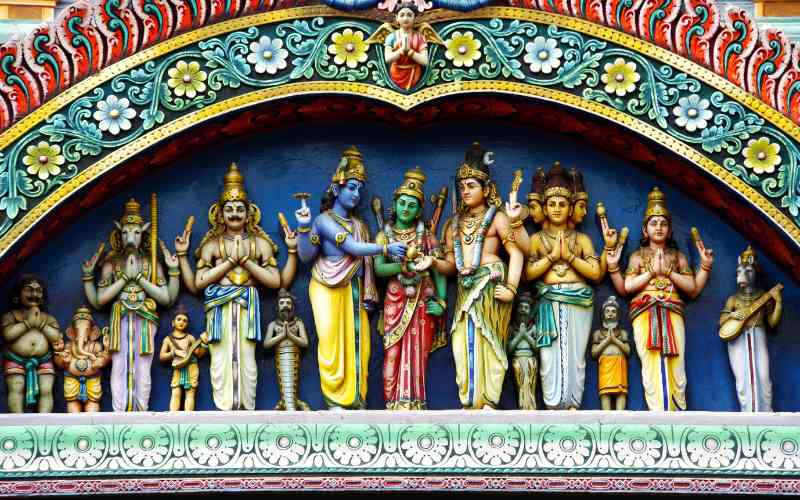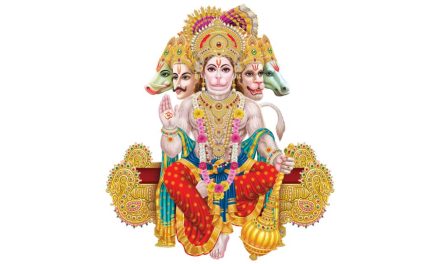The 18 major Puranas in Hinduism are ancient texts that contain stories, legends, myths, cosmology, genealogy, and theology related to various aspects of Hinduism. They are classified into three groups according to the deity they glorify Vishnu, Shiva, and Brahma. Here is a brief summary of each Purana:
- Vishnu Purana: The text primarily centers around the Hindu god Vishnu and his avatars such as Krishna, but it praises Brahma and Shiva and asserts that they are dependent on Vishnu. The Vishnu Purana is among the shorter Purana texts, with about 7,000 verses in extant versions. It presents its contents in Pancalaksana format – Sarga (cosmogony), Pratisarga (cosmology), Vamśa (mythical genealogy of the gods, sages, and kings), Manvantara (cosmic cycles), and Vamśānucaritam (legends during the times of various kings).
- Bhagavata Purana: This Purana is considered the most popular and influential among the Puranas. It focuses on the life and teachings of Krishna, the supreme personality of Godhead. It also narrates the stories of other avatars of Vishnu, such as Rama, Narasimha, and Vamana. The text’s title Bhagavata refers to the devotees of Vishnu, also known as Bhagavan. The author(s) and date of the Bhagavata Purana are unknown, and estimates place the original text to have been composed between the 8th-10th century CE. The text exists in many versions and was likely revised over time and expanded. The extant text is structured into twelve parts (skandhas), with a cumulative total of 18,000 verses.
- Narada Purana: This Purana contains the teachings of the sage Narada, who is known for his devotion to Vishnu and his role as a messenger between gods and humans. It also contains stories of various sages, kings, and devotees, as well as descriptions of holy places and rituals. The Narada Purana has about 3,000 verses in extant versions. It presents its contents in two parts – Purvabhaga and Uttarabhaga. The Purvabhaga has four sections with 125 chapters. The Uttarabhaga has 82 chapters, which include the Rukmangada-carita, a story of a king who renounces his wife for Vishnu.
- Garuda Purana: This Purana is named after Garuda, the divine eagle and the vehicle of Vishnu. It contains information on various topics such as astronomy, medicine, grammar, warfare, and ethics. It also deals with the afterlife, the law of karma, and the rites for the dead. The text is named after the bird-like avatar of Vishnu, Garuda, who also narrates the text to sage Kashyapa. The text is also attributed to Vyasa, the compiler of the Vedas. The Garuda Purana exists in many versions and contains about 15,000 verses in extant versions
- Padma Purana: This Purana is named after Padma, the lotus that emerged from Vishnu’s navel at the time of creation. It contains stories of various incarnations of Vishnu, such as Matsya, Kurma, Varaha, Narasimha, Vamana, Parashurama, Rama, Krishna, Buddha, and Kalki. It also contains descriptions of various holy places and festivals associated with Vishnu. The text is named after the lotus (Padma) in which the creator god Brahma appeared and includes large sections dedicated to Vishnu, as well as significant sections on Shiva and Shakti. The text is also attributed to Vyasa, the compiler of the Vedas. The Padma Purana exists in many versions and contains about 50,000 verses in extant versions
- Varaha Purana: This Purana is named after Varaha, the boar avatar of Vishnu who rescued the earth from the demon Hiranyaksha. It contains stories of various sages, kings, and devotees of Vishnu. It also contains information on geography, cosmology, astrology, and rituals. The Varaha Purana has two parts – Purvabhaga and Uttarabhaga. The Purvabhaga has 112 chapters and covers topics such as creation, geography, astronomy, astrology, medicine, rituals, festivals, and ethics. The Uttarabhaga has 98 chapters and covers topics such as the genealogy of kings and sages, stories of Rama and Krishna, temples, and pilgrimage sites.
- Shiva Purana: This Purana describes the greatness and glory of Shiva, the supreme lord of destruction and transformation. It contains stories of Shiva’s various forms and manifestations, such as Rudra, Maheshvara, Nataraja, Ardhanarishvara, and Linga. It also narrates the stories of Shiva’s consort Parvati and their sons Ganesha and Kartikeya. The text is also notable for including the Shatarudra Samhita, a treatise on the 1008 names of Shiva and their significance, and the Vidyeshvara Samhita, a treatise on the four Vedas and their essence. The text also has many Mahatmya chapters on geography, travel guide, and pilgrimage to holy sites such as Kashi and Prayaga.
- Linga Purana: This Purana is named after Linga, the symbolic representation of Shiva’s energy and power. It contains stories of Shiva’s creation of the universe, his battles with demons, his marriage with Parvati, and his grace to his devotees. It also contains descriptions of various forms of Linga worship and rituals. The text is also notable for being one of the early Hindu texts found in Bali, Indonesia, also called the Javanese-Brahmanda. The text also has many Mahatmya chapters on geography, travel guide, and pilgrimage to holy sites such as Kashi and Prayaga.
- Skanda Purana: This Purana is named after Skanda or Kartikeya the son of Shiva and Parvati who is also known as the commander-in-chief of the gods’ army. It contains stories of Skanda’s birth, his exploits against demons such as Tarakasura and Surapadma, his marriage with Devasena and Valli, and his worship by various sages and kings. It also contains descriptions of various holy places dedicated to Skanda. The text is also notable for being one of the most popular and widely studied texts in Hinduism.
- Brahma Vaivarta Purana: The Transformation of Brahma Purana, Brahma Vaivarta Purana is a Sanskrit text of Hinduism and one of the eighteen major Puranas. It is named after Brahma Vaivarta, which means “metamorphosis of Brahman”, who is identified with Krishna. This Purana centers around the Hindu deities Radha and Krishna and is an important Vaishnavism text. It contains stories of the creation of the universe by Krishna, his various forms and manifestations, and his interactions with various gods and goddesses such as Saraswati, Lakshmi, Ganesha, and Radha-Krishna.
- Brahma Purana: The Creator God Purana, The First Among the Trinity Purana, The Origin of the Universe Purana. Brahma Purana is a Sanskrit text of Hinduism and one of the eighteen major Puranas. It is named after Brahma, the Creator God who is considered the first among the Trinity. It contains stories of Brahma’s creation of the universe, his sons and daughters such as Daksha, Narada, and Saraswati, and his interactions with various gods and goddesses such as Vishnu, Shiva, and Durga.
- Markandeya Purana: The Immortal Sage Purana, The Conversations with Gods Purana, The Witness of Time Purana. Markandeya Purana is a Sanskrit text of Hinduism and one of the eighteen major Puranas. It is named after Markandeya, a sage who was granted immortality by Shiva. It contains stories of Markandeya’s life, his conversations with various gods and goddesses, and his witness of the end of time. It also contains the Devi Mahatmya, a famous treatise on the Goddess as the supreme power and creator of the universe.
- Vayu Purana: This Purana is dedicated to Vayu, the god of wind. It tells the stories of Vayu and his battles with demons. The Vayu Purana is one of the oldest Puranas, and it is believed to have been composed in the 1st millennium CE. It is notable for its detailed descriptions of the geography and cosmology of the Hindu world, as well as its accounts of the creation and destruction of the universe.
- Agni Purana: The Fire God Purana, The Mediator Between Gods and Humans Purana, The Encyclopedia of Knowledge Purana. Agni Purana is a Sanskrit text of Hinduism and one of the eighteen major Puranas. It is named after Agni, the Fire God who is considered as a mediator between gods and humans. It contains information on various topics such as cosmology, geography, history, politics, warfare, medicine, grammar, poetry, music, dance, architecture, sculpture, painting, and gemology.
- Kurma Purana: The Tortoise Avatar Purana, The Churning of the Ocean Purana, The Nectar of Immortality Purana. The Kurma Purana has about 6,000 verses in extant versions. It presents its contents in four parts – Brahmisamhita, Bhagavatisamhita, Saurisamhita, and Vaishnavasamhita. The text covers various topics such as cosmology, mythology, genealogy, geography, temples and pilgrimage sites, yoga, rituals, charity, and ethics.
- Vamana Purana: The Dwarf Avatar Purana, The Subduing of King Bali Purana, The Three Steps of Land Purana. The Vamana Purana has about 6,000 verses in extant versions. It presents its contents in four parts – Brahmisamhita, Bhagavatisamhita, Saurisamhita, and Vaishnavasamhita. The text covers various topics such as cosmology, mythology, genealogy, geography, temples and pilgrimage sites, yoga, rituals, charity, and ethics. The text is also notable for containing the Saro-mahatmya, a guide to the sacred sites in and around modern Haryana and eastern Punjab. The text also mentions geography and sites in South India.
- Brahmanda Purana: The Cosmic Egg Purana, The Creation by Brahma Purana, The End of Time Purana. The Brahmanda Purana has about 12,000 verses in extant versions. It presents its contents in four parts – Prakriya-pada, Anusanga-pada, Upodghata-pada, and Upasamhara-pada. The text includes the Lalita Sahasranama, a hymn praising the goddess Lalita as the supreme being in the universe, and the Adhyatma Ramayana, a philosophical version of the Ramayana that reconciles devotion to Rama with non-dualism.
- Bhavishya Purana: The Bhavishya Purana has about 14,000 verses in extant versions. It presents its contents in four parts – Brahmaparvan, Madhyamaparvan, Pratisargaparvan, and Uttaraparvan. The text includes chapters on cosmology, genealogy, mythology, geography, yoga, rituals, and ethics. The text is also notable for including the Lalita Sahasranama, a hymn praising the goddess Lalita as the supreme being in the universe, and the Adhyatma Ramayana, a philosophical version of the Ramayana that reconciles devotion to Rama with non-dualism. The text also has many Mahatmya chapters on geography, travel guide, and pilgrimage to holy sites such as Uthiramerur.
References:
- Puranas – Wikipedia. https://en.wikipedia.org/wiki/Puranas
- Puranas – Friendly Hindu Treatises From Ancient India – Learn Religions. https://www.learnreligions.com/what-are-puranas-1770567
- 18 Puranas & Their Secrets In Hinduism (Explained) | K.Guide. https://kivabeguide.com/complete-list-of-puranas-hinduism/
- Wisdom Library: A digital library of books and articles on various topics related to religion, philosophy, history, and culture. https://www.wisdomlib.org/hinduism
- Sacred Texts: A comprehensive archive of online texts on religion, mythology, folklore, and the esoteric. https://www.sacred-texts.com/hin/index.htm
- Holy Books: A collection of free PDF e-books on spirituality, religion, and philosophy. https://www.holybooks.com/category/hinduism/
- Vedabase: An online library of Vedic literature, including the Bhagavad-gita, Srimad-Bhagavatam, and other scriptures of the Gaudiya Vaishnava tradition. https://vedabase.io/en/library/
- Hindu Website: A portal for information and resources on Hinduism, Buddhism, Jainism, Sikhism, and Zoroastrianism. https://www.hinduwebsite.com/sacredscripts/puranas.asp
- Hindupedia: An online encyclopedia of Hinduism, covering various aspects of the religion such as scriptures, philosophy, culture, and history. https://www.hindupedia.com/en/Puranas
- Speaking Tree: A website for spiritual networking and blogging, featuring articles and videos on various topics related to spirituality and wellness. https://www.speakingtree.in/allslides/the-18-puranas-and-their-speciality
- Bhagavad-Gita.us: A website dedicated to the study and dissemination of the Bhagavad-gita, with translations, commentaries, and articles. https://www.bhagavad-gita.us/the-eighteen-puranas/





